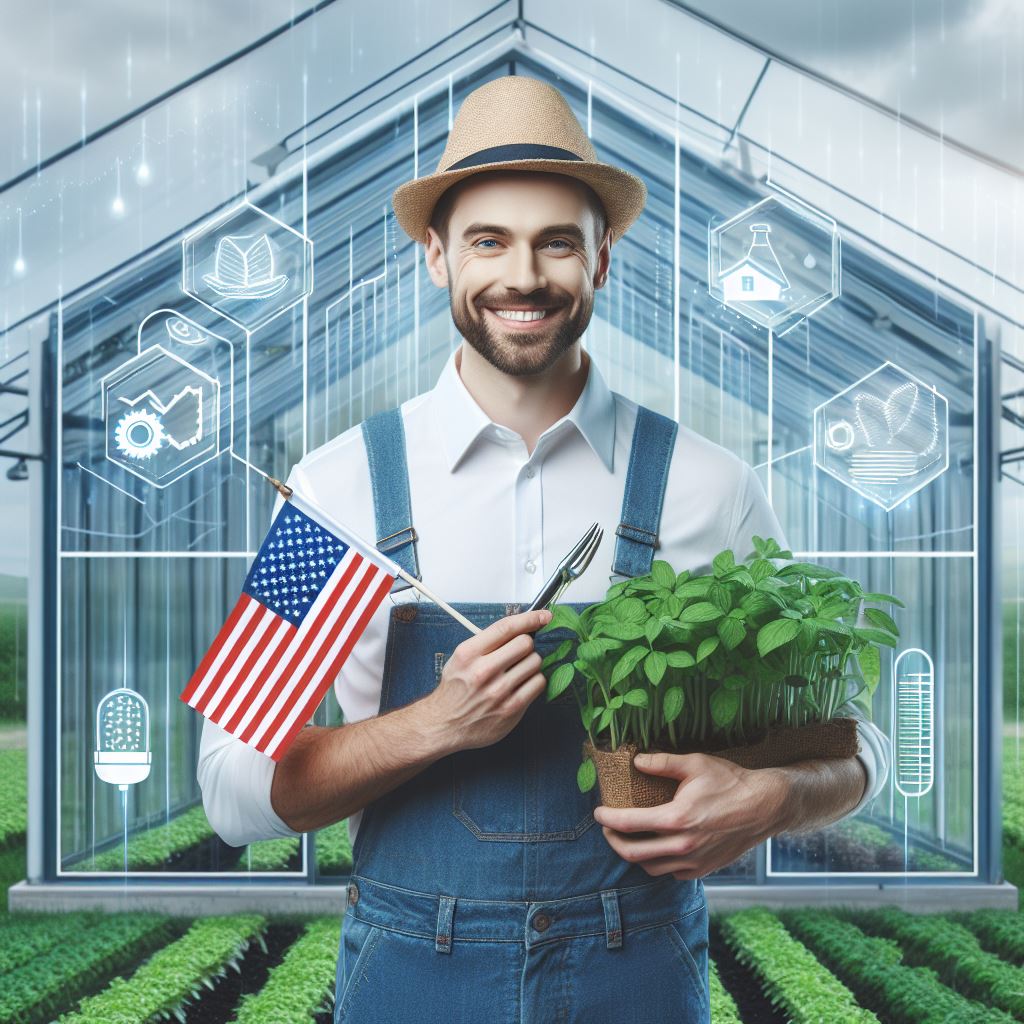Introduction
Brief background on the topic of smart greenhouses
Smart greenhouses are revolutionizing the way we approach agriculture, offering a sustainable and efficient solution to grow crops.
These high-tech structures utilize advanced technologies to optimize resource usage, providing an ideal environment for plant growth.
However, their successful implementation heavily relies on understanding the policy dynamics in the United States.
Importance of understanding US policy dynamics pertaining to smart
Understanding US policy dynamics pertaining to smart greenhouses is vital for several reasons.
Firstly, policymakers play a crucial role in shaping the future of agriculture.
Their decisions on regulations, incentives, and funding can either hinder or facilitate the adoption of smart greenhouse technologies.
Additionally, comprehending the policy landscape helps industry stakeholders navigate legal frameworks and plan investments accordingly.
Overview of what the blog post will cover
This blog post aims to provide a comprehensive overview of US policy dynamics related to smart greenhouses.
It will delve into the historical context, examining the evolution of agricultural policies and their impact on modern greenhouse technologies.
Furthermore, specific policies and initiatives that promote or hinder the development of smart greenhouses will be analyzed.
To understand the current policy dynamics, factors like government support, research funding, and sustainability initiatives will be explored.
Moreover, the blog post will assess the role of federal, state, and local governments in shaping smart greenhouse regulations.
This analysis will shed light on the challenges and opportunities faced by stakeholders in implementing and scaling up smart greenhouse projects in the US.
By examining the policy dynamics surrounding smart greenhouses in the United States, this blog post aims to equip readers with valuable insights to navigate the legal, regulatory, and financial landscape.
Understanding these dynamics is vital for the successful adoption and growth of smart greenhouses, ensuring sustainable and efficient agriculture for the future.
Transform Your Agribusiness
Unlock your farm's potential with expert advice tailored to your needs. Get actionable steps that drive real results.
Get StartedSmart Greenhouses: Definition and Benefits
Explanation of what smart greenhouses are and their main features
Smart greenhouses are advanced agricultural structures equipped with modern technology to optimize plant growth.
These structures incorporate automated systems for monitoring and controlling various environmental factors, such as temperature, humidity, light, and CO2 levels.
The key features of smart greenhouses include sensors, actuators, and a centralized control system that allows growers to manage cultivation conditions remotely.
Discussion on the advantages of using smart greenhouses in agriculture
- Increased crop yield and quality: Smart greenhouses create an ideal environment for plant growth, resulting in higher yields and improved crop quality. The precise control of temperature, humidity, and light levels ensures optimal conditions for plants to thrive.
- Water and energy efficiency: By utilizing smart irrigation and energy management systems, water and energy consumption in smart greenhouses can be significantly reduced. The sensors and automation technology allow growers to determine precise watering needs, thereby conserving water resources. Additionally, smart greenhouses integrate renewable energy sources, such as solar panels, to power their operations.
- Climate control and pest management: Smart greenhouses enable precise climate control, protecting plants from extreme weather conditions and pests. The automated systems monitor and adjust temperature, humidity, and ventilation, creating an optimal climate for plant growth. Integrated pest management techniques, such as insect traps and biological controls, help minimize the use of chemical pesticides.
Smart greenhouses revolutionize agriculture by providing numerous benefits to growers, consumers, and the environment.
These advanced structures combine technology and sustainable practices to enhance productivity and reduce resource consumption.
By integrating automation and control systems, smart greenhouses offer an innovative approach to agricultural cultivation.
Read: 2024 Farm Bill: Key Changes Explained
Current US Policy Landscape regarding Smart Greenhouses
Overview of existing policies related to agriculture and greenhouse operations
Currently, the United States has several policies in place that impact agriculture and greenhouse operations.
These policies aim to regulate and support the industry while ensuring environmental sustainability and food security.
One such policy is the Farm Bill, a comprehensive legislation that addresses various agricultural issues, including greenhouse operations.
The Farm Bill provides funding and resources for research, infrastructure development, and the adoption of innovative technologies in agriculture, including smart greenhouse technologies.
In addition to the Farm Bill, there are also federal regulations and standards that govern greenhouse operations.
These regulations focus on ensuring the safety of workers, protecting the environment, and maintaining the quality of agricultural products.
Identification of specific policies impacting the adoption of smart greenhouse technologies
- Federal regulations and standards: The federal government has implemented regulations and standards that directly impact the adoption of smart greenhouse technologies. These regulations ensure that smart greenhouses meet safety and environmental requirements.
- Incentives and funding opportunities: The federal government provides incentives and funding opportunities to promote the adoption of smart greenhouse technologies. These incentives include tax credits, grants, and low-interest loans for farmers and greenhouse operators.
- State-level initiatives and regulations: Several states have taken the initiative to implement their own policies and regulations regarding smart greenhouse technologies. These state-level initiatives aim to support innovation and sustainable agriculture practices.
Overall, the current US policy landscape regarding smart greenhouses encompasses a combination of federal regulations, incentives, and state-level initiatives.
These policies aim to support the adoption of smart greenhouse technologies, promote sustainability in agriculture, and ensure the production of high-quality and safe agricultural products.
However, there is still room for improvement and further development of policies to address emerging challenges and promote the widespread adoption of smart greenhouse technologies across the nation.
Read: Animal Welfare Law: What’s New in 2024?
Recent Changes in US Policies
Analysis of the latest updates to the US policy landscape
- The US government has recently made certain revisions to its policies regarding smart greenhouses.
- These changes aim to address the increasing global focus on sustainable agricultural practices.
- An analysis of the latest updates reveals a shift towards promoting the adoption of smart greenhouse technologies.
- The government recognizes the potential of these technologies in improving crop yields while reducing environmental impact.
- Various federal agencies are actively engaging in research and development, funding initiatives, and policy formation.
- This analysis indicates a positive trend towards supporting the growth and deployment of smart greenhouses nationwide.
Examination of any new legislation or regulations relevant to smart greenhouses
- In recent years, the US has witnessed the introduction of several new legislations and regulations pertaining to smart greenhouses.
- These measures focus on providing incentives and tax benefits to encourage the adoption of smart greenhouse technologies.
- Government agencies are collaborating with industry experts to establish guidelines and standards for smart greenhouse operations.
- New regulations also address issues such as energy efficiency, water conservation, and the use of sustainable materials.
- Implementation of these legislations ensures a comprehensive framework for the development and operation of smart greenhouses.
- Public-private partnerships are being formed to create funding opportunities and facilitate the integration of advanced technologies in the industry.
Impact of these changes on the deployment and development of smart greenhouse technologies
- The recent changes in US policies have had a significant impact on the deployment and development of smart greenhouse technologies.
- The government’s support and financial incentives have encouraged farmers and entrepreneurs to invest in smart greenhouse solutions.
- New legislation and regulations have streamlined the approval process for establishing smart greenhouse operations.
- This has resulted in a rapid increase in the number of smart greenhouses across the country.
- Technological advancements, driven by government policies, have led to improved automation, monitoring, and control systems in smart greenhouses.
- Additionally, the integration of renewable energy sources and innovative irrigation systems has enhanced the sustainability of these facilities.
- The impact of these changes extends beyond the agricultural sector, with job creation and economic growth being stimulated.
- Furthermore, the adoption of smart greenhouse technologies contributes to the overall reduction of carbon emissions and environmental preservation.
- Overall, the recent policy changes have accelerated the growth of smart greenhouse technologies in the US, shaping a greener and more sustainable future.
By closely examining recent updates, new legislations, and their impact, it becomes evident that the US is committed to promoting smart greenhouses as a viable solution to enhance agricultural productivity while reducing environmental harm.
With a supportive policy landscape, the deployment and development of smart greenhouse technologies are poised to flourish, ensuring a more sustainable and efficient agricultural sector.
Read: USDA Updates 2024: What’s New?

Challenges and Opportunities
Collaborative efforts between policymakers, researchers, and industry stakeholders
Collaboration between policymakers, researchers, and industry stakeholders is crucial to address the challenges faced by smart greenhouses.
By working together, they can develop effective policies, share knowledge, and promote innovation in this field.
Education and awareness campaigns to promote the benefits of smart greenhouses
One of the main obstacles to the adoption of smart greenhouse technologies is the lack of awareness about their benefits.
Education campaigns aimed at farmers, consumers, and the general public can help in dispelling misconceptions and highlighting the advantages of these technologies, such as increased crop yield, resource efficiency, and environmental sustainability.
Showcase Your Farming Business
Publish your professional farming services profile on our blog for a one-time fee of $200 and reach a dedicated audience of farmers and agribusiness owners.
Publish Your ProfileEconomic incentives and support for farmers transitioning to smart greenhouse practices
Transitioning to smart greenhouse practices can be costly for farmers, especially small-scale ones.
Providing economic incentives and support, such as grants, subsidies, and low-interest loans, can help alleviate the financial burden and encourage more farmers to adopt these technologies.
Governments and organizations should also offer technical assistance and training programs to ensure successful implementation.
The challenges in the widespread adoption of smart greenhouse technologies are not insurmountable.
With proactive measures and collective efforts from various stakeholders, these challenges can be overcome, leading to a more sustainable and efficient agriculture sector.
Read: Latest USDA Subsidies: An Overview
Case Studies and Success Stories
Presentation of real-world examples showcasing successful implementation of smart greenhouses
The presented case studies demonstrate that the successful adoption of smart greenhouses relies on a combination of supportive policies, strategic partnerships, and a commitment to continuous improvement.
By showcasing real-world examples, policymakers and farmers can gain valuable insights into the potential benefits and challenges of implementing these technologies.
Examination of the policies and strategies that contributed to these success stories
The Dutch government’s financial support and research grants enabled Porta Nova to implement smart greenhouse systems, resulting in increased crop yields and cost reduction.
Japan’s government offered tax incentives and research funding, driving the adoption of smart greenhouse practices at Chiba University and improving crop quality and resource efficiency.
In the United States, Idaho’s state government facilitated collaborations between the agricultural sector and technology companies, leading to productivity gains and energy savings at the Magic Valley greenhouse.
Lessons learned from these case studies for policymakers and farmers interested in smart greenhouse adoption
From these case studies, several lessons can be learned.
Policymakers should prioritize providing access to funding and research support, as financial barriers can hinder adoption.
Offering incentives, such as tax breaks and grants, can encourage farmers to invest in smart greenhouse technologies.
Collaboration between the agricultural sector and technology companies is essential for innovation and continuous improvement.
Continuous monitoring and data analysis are critical for optimizing resource usage and enhancing crop quality.
Education and training programs should be implemented to equip farmers with the necessary skills to effectively utilize smart greenhouse technologies.
Therefore, the success stories presented in these case studies highlight the potential of smart greenhouses.
Policymakers and farmers can draw on the lessons learned from these examples to foster the adoption of these technologies.
Through supportive policies, strategic partnerships, and a commitment to continuous improvement, smart greenhouses can revolutionize agriculture by maximizing resource efficiency and improving crop yields.
Future Outlook and Policy Recommendations
Overview of future trends and advancements in smart greenhouse technologies
In the coming years, smart greenhouse technologies are expected to advance rapidly. These advancements include:
- Integration of Internet of Things (IoT) technology: IoT will enable the collection and analysis of real-time data to optimize greenhouse conditions and improve crop yields.
- Artificial intelligence and machine learning: AI algorithms will be utilized to automate various processes in smart greenhouses, such as irrigation, ventilation, and pest control.
- Sensing and monitoring technologies: Advanced sensors and monitoring systems will continually assess environmental parameters such as temperature, humidity, CO2 levels, and light intensity to ensure ideal growing conditions.
- Energy efficiency and sustainability: Future smart greenhouses will prioritize energy efficiency through technologies such as solar panels, LED lighting, and energy storage systems. They will also incorporate sustainable practices such as water recycling and organic pest management.
Proposal of potential policy recommendations to further support the growth of smart greenhouses in the US
To ensure the continued growth and success of the smart greenhouse industry in the United States, the following policy recommendations are proposed:
- R&D funding for innovation and technology development: Increase funding for research and development programs focused on smart greenhouse technologies. Support partnerships between academic institutions, research organizations, and industry players to promote innovation.
- Streamlining regulations to encourage adoption and reduce barriers: Develop clear and standardized regulations for smart greenhouse technologies to facilitate their adoption. Provide financial incentives, such as tax credits or grants, to encourage farmers and greenhouse operators to invest in smart technologies.
- Promotion of public-private partnerships and knowledge sharing: Foster collaborations between government agencies, private companies, and educational institutions to share best practices and resources. Establish platforms or networks for knowledge sharing, allowing stakeholders to exchange information on technological advancements, policy updates, and success stories.
By implementing these policy recommendations, the US can create an enabling environment for the growth of smart greenhouses, leading to various benefits:
- Increased agricultural productivity and crop yields due to optimized growing conditions and automation.
- Enhanced resource efficiency through reduced water and energy consumption.
- Improved food security and reduced dependency on imported produce.
- Job creation opportunities in the field of smart greenhouse technology development, installation, and maintenance.
In short, the future of smart greenhouses in the US looks promising.
With advancements in technology and the right policy support, these sustainable and efficient farming systems can revolutionize the agricultural sector.
By prioritizing R&D funding, streamlining regulations, and fostering public-private partnerships, the US can position itself as a leader in smart greenhouse technologies, benefiting both farmers and the environment.
Explore Further: How Tariffs Impact American Farmers
Conclusion
Smart greenhouses represent a transformative approach to agriculture, integrating advanced technology to optimize crop production while minimizing environmental impact.
In the United States, the evolution of policies surrounding smart greenhouse technology has significant implications for farmers, researchers, and policymakers alike.
As discussed, the key points underscore the importance of understanding US policy dynamics in the context of smart greenhouses:
- Policy Impact: US policies directly influence the adoption and implementation of smart greenhouse technology, shaping the regulatory landscape and funding opportunities.
- Regulatory Frameworks: Farmers and industry stakeholders must navigate complex regulatory frameworks to ensure compliance with standards related to environmental conservation, energy usage, and food safety.
- Economic Opportunities: Smart greenhouses present economic opportunities for farmers to increase productivity, reduce resource consumption, and access new markets, but policy support is crucial to unlocking their full potential.
- Environmental Sustainability: Policies promoting sustainable agricultural practices play a vital role in encouraging the adoption of smart greenhouse technology, contributing to long-term environmental conservation efforts.
Stakeholders invested in the smart greenhouse industry must stay informed and engaged with US policy developments.
By advocating for supportive policies and fostering collaboration between government agencies, industry players, and research institutions, we can accelerate the adoption of smart greenhouse technology and drive positive change in agriculture.




